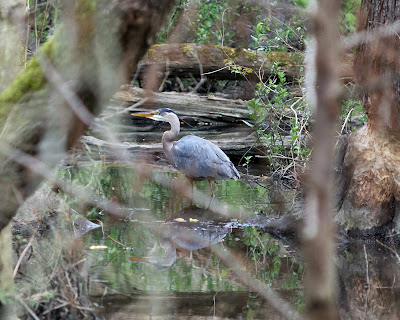Additional Photo of Heron Rookery in Kenmore.
Thanks to Vicki Westberg for sending this photo of the remarkable Heron Rookery in Kenmore.
Next to an ugly municipal parking lot is a remarkable resource. Kenmore hosts the Heron Rookery,
which is home to at least 55 nests and likely over 100 Great Blue Herons. This is a vast wetland, which is a part of the huge Swamp Creek Watershed, which feeds Lake Washington. It is an amazing site to see in the middle of a suburban city. If you see a heron in your neighborhood, it may actually live here or maybe at Kiwanis Ravine on Magnolia Bluff.
Let us know if you see one or if there are other heron nesting sites.
Thanks Vicki and Jan Stewart for making the treck over to Kenmore. Thanks Kenmore for preserving this amazing wildlife habitat.
Washington Department of Fish and Wildlife hosts a webcam at the Kenmore Library.
http://wdfw.wa.gov/wildwatch/heroncam/
Wildlife Photo Feature - Great Blue Heron seen April 12th at Thornton Creek Park # 6.
It was reported by Ruth Williams of TCA that it consumed two fish in five minutes. This is significant because the huge bird was sighted in the Beaver Pond and that fish were this plentiful. It took activists many years to convince the City that there is fish habitat worth protecting in Thornton Creek. This site is just 3 blocks from Northgate and the Thornton Place development and the
SPU Thornton Creek Water Quality Channel. The
Thornton Creek Legal Defense Fund and many others, fought for many years to
ensure that the project was built and designed with fish passage protections. The project designers have won several awards including a recent WASLA award.
There are several well known "heron rookeries" or nesting sites in the area, which are protected by State law. Seattle hosts one at Kiwanis Ravine in the Magnolia neighborhood. Kenmore and the Renton also have large rookeries.
Earthcorps has held work parties and restoration projects there, co-sponsored by
Heron Habitat Helpers.
Photo Credit - Don MacCall and Ruth Williams
The Great Blue Heron is considered a "Priority Species" by WA State.
Great Blue Heron Facts
- The Great Blue Heron belongs to a large family that includes herons, egrets, and bitterns. This world-wide family has about 60 species. The Great White Heron of Florida is a local color variation of the Great Blue and belongs to the same species.
- The Great Blue Heron’s long legs allow it to hunt in deeper water than most other herons and egrets.
- Herons have special patches of powder down feathers, which they rake with a foot, causing the powder to fall on fish it has caught. The powder causes the fish slime and oil to clump up so that the herons then can simply brush it off with a foot. Herons also rub the powder especially on the underside of their bodies to repel swamp slime and oils.
- The Great Blue Heron can swallow a fish many times wider than its narrow neck.
- Herons look for food anytime there is enough light. Studies suggest that cloudy weather is ideal for the birds to look for fish. Herons don’t just eat fish, however. They eat a wide variety of prey, including frogs, salamanders, turtles, snakes, insects, rodents, and small birds.
- In catching fish, the Great Blue Heron grabs smaller fish between the two mandibles of its bill; with a quick strike it stabs the larger fish.
- In the Pacific Northwest, eelgrass beds are important foraging sites for the Great Blue Heron.
- Herons nest in colonies. One of the largest colonies in Washington is located in Renton; last year there were approximately 135 active nests there.
- Great Blue Herons often reuse a nest, adding sticks to it each year. The male brings sticks and the female works them into the nest. Older nests can be recognized by their large size.
- Great Blue Herons lay from three to seven eggs, but the usual number is four.
- Young Great Blue Herons are semialtrical: they emerge from the eggs with a downy coat and their eyes open, but they aren’t able to move about and must be fed by their parents. They grow to adult size in about six weeks.
- Heron chicks are often aggressive toward each other, and some are pushed out of the nest.
- Adult Great Blue Herons have no natural predators, although bobcats and coyotes occasionally kill one while feeding on the ground. Young herons in the nest are often killed by crows, ravens, gulls, hawks, eagles, and raccoons. Eagles have been known to cause entire heron colonies to fail.
- It is dangerous to handle a Great Blue Heron. It can strike quickly; its bill is strong and very sharp and can cause serious injury.
- The Great Blue Heron breeds throughout North and Central America, the Caribbean, and the Galapagos Islands. Some populations migrate to South America for the winter.
- Adult herons stand around three feet tall, but can stretch to about four feet; their wingspan is about six feet. These large birds weigh only about 5 to 6 pounds.
- The Great blue Heron has special neck vertebrae that allow the neck to curl into an “S” shape, and its structure allows a lightning-quick strike at prey. In flight the neck is folded back into the S-shape and the legs are stretched out behind them.
- In flight Great Blue Herons average about 25 mph, their maximum flight speed can approach 35 mph.
- In the nineteenth century herons and egrets were hunted for their plumes. These beautiful feathers were popular decorations for women’s hats. Some heron species were severely depleted by hunting, which was outlawed in the early twentieth century.
|









Thanks Janet for this wonderful blog. This was an especially inspiring post!
ReplyDeleteSaskia
That's wonderful!
ReplyDelete